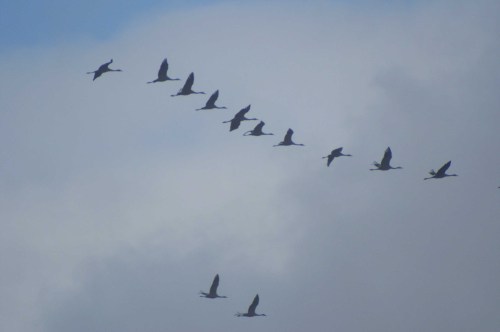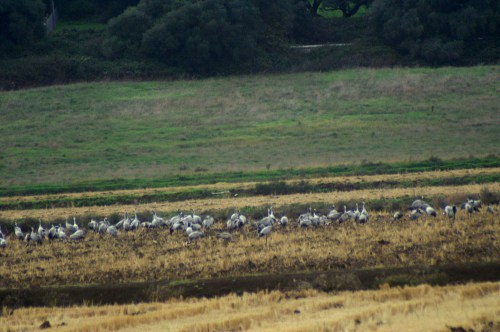For me, no winter trip to La Janda would be complete without the sightings and sounds of the beautiful and most elegant of birds, the Common Cranes. Wintering flocks of Common Cranes usually begin to arrive at La Janda from late October-early November and are around until February. The flocks are dynamic, particularly at the ‘arrival’ and ‘departure’ stages as many birds use the site as a staging area before moving on to cross the Strait to destinations in Africa, or before beginning the journey back to their breeding grounds, but it is estimated that the numbers that remain range from 200-500 in most years.
FACTS ABOUT THE COMMON CRANE (from Birdlife)
Scientific name: Grus grus
Status according to IUCN Red List: Least concern
Estimated population: 360,000 – 370,00 mature individuals
Migration: This species is fully migratory, usually utilising two major migration routes (south-west, and south to south-east passages across Europe) and uses regular staging areas. Family groups and non-breeding birds begin to migrate from their breeding grounds in July, but the majority of the species migrate in early September, arriving in African wintering grounds during October. The species returns to its breeding areas in March, where breeding begins in late April or early May, occasionally up to three weeks earlier in southern areas. It is gregarious for much of the year, migrating in flocks of between 10-50 to 400 birds (Africa) and congregating in groups of few to 1,000 birds in the non-breeding season.
Non-breeding habitat: The non-breeding wintering and migration habitats of the species include floodland, swampy meadows, shallow sheltered bays, rice paddies, pastures and savannah-like areas (such as open holm oak woodlands in the Iberian Peninsula). The species may also be found roosting on mudflats or sandbanks along rivers, lakes and reservoirs during this season and undertake flights of up to 20 km1 to forage in agricultural fields (due to human encroachment and destruction of its preferred habitats). Diet The species is omnivorous in both breeding and non-breeding seasons, the plant component of its diet consisting of grass roots and shoots, rhizomes, tubers (e.g. potatoes), the leaves of crops and wild herbs (e.g. brassicas, clover, nettle, chickweed), pondweed, the berries of Empetrum and Vaccinium, cereal grain (e.g. wheat, barley, oats, rye, maize, rice), peas, olives, acorns, cedarnuts, groundnuts Arachis, and the pods of Cajanus,. Animal matter in this species’ diet includes adult (beetles, flies) and larval (Lepidoptera) insects, snails, earthworms, millipedes, spiders, woodlice, frogs, slow-worms, lizards, snakes, small mammals (rodents and shrews), fish and occasionally the eggs and young of small birds.
Threats: In both its breeding and non-breeding ranges this species is principally threatened by habitat loss and degradation through dam construction, urbanisation and agricultural expansion (including changes in land-use, intensification, expanded irrigation systems and conversion of traditional holm oak pastures)
(information taken from http://www.birdlife.org)
Over the years we have been treated to some amazing views of these charismatic visitors, but the most memorable sightings remain those I had on the very first visit I made to La Janda with two friends, in December 2005. We had driven all the way there in bright sunshine, but as we drove into the site we encountered thick, damp mist, a fairly frequent occurrence during wet winters. Every bird was silent and grounded, waiting patiently for the sun to burn off the mist, and as our eyes adjusted we could make out some of their outlines on various perches. We left the car and walked down the muddy track to see what we could identify from their outlines, it was then that we heard the unmistakeable honking sounds of approaching Cranes. Within seconds they were there, huge shapes emerging from the mist, flying in low down, right over our heads; we guessed they most probably hadn’t seen us.
The birds seemed to be quite put out by the reduced visibility and made several large circuits around the site before disappearing from view; we assumed they had eventually settled somewhere.
As the mist lifted, more birds began arriving but we didn’t sight them again until later, after we had driven a good way into the site.
Gregarious birds, the Cranes gather together and form large feeding flocks that are very often only properly visible through binoculars or a telescope, as they tend to be at the backs of the fields we pass by on the main track; small groups can frequently be seen leaving or joining them, with each arrival causing a bit of a kerfuffle as they settle in.
Smaller more mobile groups can often be found feeding in fields closer to view, often in twos, threes or fours and are likely to be a family that will have travelled here together.


















